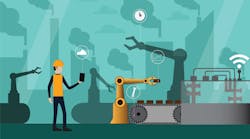Since the invention of the assembly line, manufacturers have become experts in developing processes that boost efficiency and streamline the factory floor. To go even faster, manufacturers should invest in the long game by prioritizing the development of their digital ecosystem.
“Only 36% of global purchase influencers in the manufacturing sector consider accelerating the shift to digital business to be a high priority for their organization.” (From Grease to Code: Industrial Giants Must Bet Their Futures on Software, Forrester Research, April 24, 2019). Instead of transforming how they do business and exchange data, which could dramatically reduce expenses, many organizations opt for short-term operational goals that shave only 1 to 2% off the cost of an established process.
The larger business efficiencies for manufacturers depend on their ability to fully integrate the supply chains from raw materials to customers. To get ahead (and stay ahead), manufacturers should be working to build their digital ecosystem so isolated components of the organization can work in harmony. This enables them to access and act on critical data and troubleshoot production and quality issues early. A connected digital ecosystem also allows for direct sales through e-commerce channels and servicing the products to ensure the best customer experience.
Simple point solutions are faster to deploy but have dramatically less ROI over time.
Go Big or Go Home
Manufacturers can respond to the digital-first disruptors by adopting data collection and machine learning technology solutions that improve communication about and between siloed entities. More complete information and real-time data analysis mean less scrap, higher service and product quality, and higher profits. Daniel Newman, principal analyst of Futurum Research, explains, “Smart factories with integrated IT systems provide relevant data to both sides of the supply chain more easily, increasing production capacity by 20%.”
Building a digital ecosystem is a serious overhaul. It takes financial resources, top-down leadership buy-in and time. But connecting all the data–from build-out to logistics to product design to customer support–produces more informed insights that lead to better decision-making and longer-lasting impact on the bottom line.
Predict Maintenance Needs To Lower Costs
Standardized maintenance schedules are the norm for most manufacturers. However, the plan can quickly break down when machinery degrades unexpectedly, disrupting production and causing costly unscheduled events. By collecting signals on how different equipment and processes are operating and applying AI and systems models, we can now predict problems before they happen to save time and money through early intervention and help prioritize maintenance schedules accordingly.
For example, Trenitalia, the primary train operator in Italy, recently adopted connected business processes to capture signals from their trains, analyze the information, and predict maintenance needs to cut down on unanticipated downtime. According to Trenitalia CIO Danilo Gismondi:
“A new train can generate 5,000 signals per second, measuring speed, vibration, temperature, location, and the state of every critical component, from wheels and brakes to exterior doors and toilets. Analysis of the data lets Trenitalia shift from standardized maintenance schedules across an entire class of locomotives to predictive models potentially optimized for individual members of the fleet. Trenitalia aims to cut its €1.3 billion maintenance budget by 8% to 10% as a result.” (From Grease to Code: Industrial Giants Must Bet Their Futures on Software, Forrester Research, April 24, 2019)
Connect the Supply Chain
Equipment is only one piece of the puzzle. Processes, systems, and people involved in the supply chain can also have a major impact on production. It can be difficult for cross-functional teams to track and accomplish their shared goals. In order to smooth the flow from the design to the build to the customer, manufacturers should invest in technology that allows them to quickly aggregate and analyze data to see where problems are occurring along any part of the engineering process, sales cycle, and customer journey. Louis Columbus, Principal, IQMS, part of Dassault Systèmes, explains:
“Machine learning has the potential to bring an entirely new level of insight and intelligence into these teams, making their goals of optimizing production workflows, inventory, Work In Process (WIP), and value chain decisions possible.”
Seeing how the dots connect sooner is critical to addressing issues. For example, when something goes wrong, like a batch of tainted romaine lettuce appearing in supermarkets across the country, it’s paramount to identify the source, formulate corrective action, and disseminate the information to all stakeholders. With AI-powered search and connected data sources, companies can quickly identify where the lettuce originated from, what aspects of it were flawed, and where they were shipped. This means that when a complication arises, companies can provide more targeted recalls before it snowballs into a larger issue.
Invest in Digital, From Build To Sale To Support
Digital transformation isn’t a one-process-at-a-time decision and it’s not a small operational shift. It’s an entirely new way of doing business.
To develop a winning digital strategy, connect the dots of your digital ecosystem. Similar to the way the manufacturing process turns raw material to a finished product, invest in technology that allows you to take data (raw material), build insights and use it to improve your sourcing and engineering processes and ultimately the quality of your product. Finally, present and distribute the finished product through the channels favored by your customers, which are increasingly digital. Put digital at the core of your business to take the next necessary step towards innovation in manufacturing.
Ready to learn more? Read “How IoT & Industry 4.0 Relate — and Why Manufacturers Should Care.”










